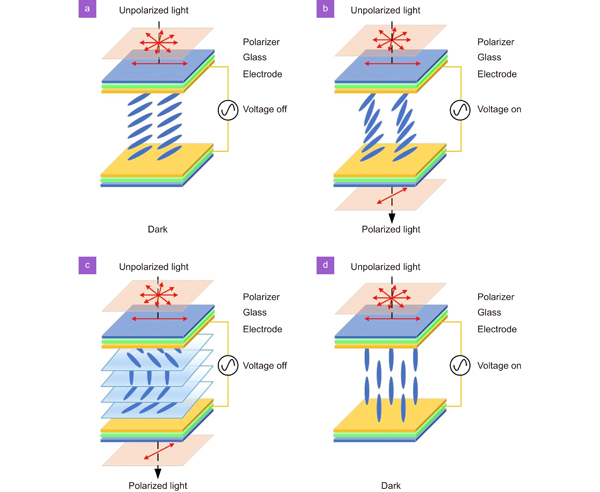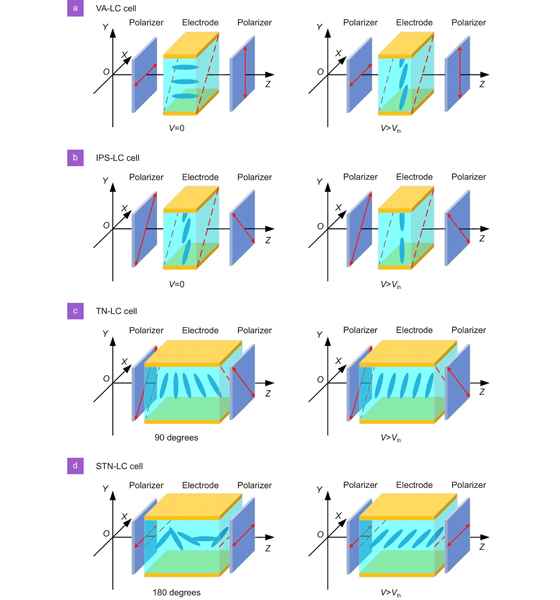Yiqian Yang, Andrew Forbes, Liangcai Cao. A review of liquid crystal spatial light modulators: devices and applications[J]. Opto-Electronic Science, 2023, 2(8): 230026-1
Search by keywords or author
- Opto-Electronic Science
- Vol. 2, Issue 8, 230026-1 (2023)

Fig. 1. Working principle of liquid crystals. In the electro-optic birefringent effect, (a ) no light is outputted when the voltage is off, while (b ) polarized light is outputted when the voltage is on. In the twisted nematic effect, (c ) the molecular orientations of the upper and lower crystal planes of the liquid crystal are different. Molecules rotate uniformly along the crystal direction without voltage. (d ) Molecules deviate from the original direction and align towards the electric field when the voltage is on.

Fig. 2. Models of liquid crystal cells. (a ) Model of VA-LC cell. Under the application of an electric field, the liquid crystal molecules tilt at 45 degrees relative to the axes of the polarizer. (b ) Model of IPS-LC cell. Under the application of an electric field to the liquid crystal cell in the X-Y plane, the liquid crystal molecules align in the direction of the field. (c ) Model of TN-LC cell with a twist angle of 90 degrees in total. The liquid crystal vectors of the area between the glass plates undergo a continuous and uniform distortion of 90 degrees without voltage. (d ) Model of STN-LC cell with a twist angle of 180 degrees in total. V represents the voltage, Vth represents the threshold voltage of the liquid crystal cell.
Fig. 3. The performances of LC-SLMs have significantly improved with continuous advancements in material research and significant investments in advanced manufacturing technologies. These led to a decrease in the pixel pitch to the micrometer level and an increase in the number of pixels to tens of millions.
Fig. 4. Apparatus of LC-SLM and SLM holograms that produce different types of beams. (a ) LC-SLM can be designed or calculated to replace typical analytic and numeric elements to realize the modulation of the light field in (b ) amplitude, phase and polarization. (c ) Various types of beams, such as Bessel beams, finite-energy Airy beams, Hermite-Gauss beams, Laguerre-Gauss beams, and optical vortex beams, can be obtained by uploading holograms into the LC-SLM. (d ) Different types of structured lights detected by a CCD.
Fig. 5. LC-SLMs are versatile and powerful devices that find diverse applications, including beam shaping and steering, holography, optical trapping and tweezers, measurement, wavefront coding, optical vortex, and quantum applications. The unique properties, such as high resolution, high speed, and dynamic control, make them well-suited for use as dynamic optical devices in a wide range of applications.
Fig. 6. Applications of LC-SLMs in beam shaping and steering. (a ) Generating 3D vectorial multifocal arrays by pseudo-period encoding. (b ) Ultrafast fabrication of micro-supercapacitors using laser photonic-reduction stamping. Figure reproduced with permission from: (a) ref.61, IOPscience; (b) ref.82, Springer Nature.
Fig. 7. Applications of LC-SLMs in holography. (a ) High-accuracy generation of CGHs by angular-spectrum layer-oriented method. (b ) Real-time photorealistic 3D holography with deep neural networks. Figure reproduced with permission from: (a) ref.88, OSA Publishing; (b) ref.89, Springer Nature.
Fig. 8. Applications of LC-SLMs in optical trapping and tweezers. (a ) An optical analog of Archimedes’ screw for particle trapping and conveying. (b ) The first optical trapping experimental demonstration of microparticles with frozen waves. Figure reproduced from: (a) ref. 116, OSA Publishing; (b) ref. 137, OSA Publishing.
Fig. 9. Applications of LC-SLMs in measurement. (a ) In situ wavefront calibration based on digital holography. (b ) Coherent optical adaptive technique can increase the spatial resolution of STED microscopy in thick samples. Figure reproduced with permission from: (a) ref.151, SPIE; (b) ref.159, OSA Publishing.
Fig. 10. Applications of LC-SLMs in wavefront coding. (a ) Endoscopic interferenceless coded aperture correlation holography (EI-COACH) for high-resolution coded aperture imaging. (b ) Ultrasound-induced field perturbation (UFP) for focusing light into scattering media and speckle imaging. Figure reproduced with permission from: (a) ref.174, OSA Publishing; (b) ref.186, Springer Nature.
Fig. 11. Applications of LC-SLMs in optical vortex. (a ) Optical vortex array generation aligned along an arbitrary curvilinear path. (b ) Optical communication beyond orbital angular momentum can generate over 100 channels with one hologram. Figure reproduced with permission from: (a) ref.216, OSA Publishing; (b) ref.235, Springer Nature.
Fig. 12. Applications of LC-SLMs in quantum applications. (a ) High dimensional and multidimensional entanglement with structured light. (b ) Quantum entanglement swapping of multiple orbital angular momentum states of light simultaneously. Figure reproduced with permission from: (a) ref.237, AIP Publishing LLC; (b) ref.256, Springer Nature.
|
Table 1. Performances of commercially available spatial light modulators.

Set citation alerts for the article
Please enter your email address



